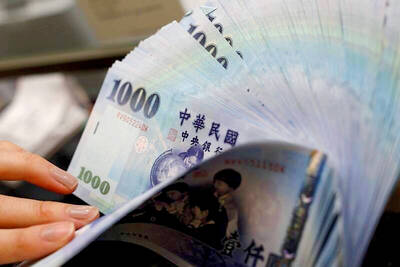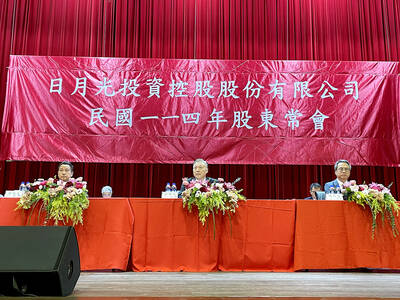Alcohol-free drinks are becoming ever more popular, especially with health-conscious younger people — a trend cheered by a small German winery based in a Rhine Valley castle.
While demand for zero-alcohol beer has risen strongly, the family business is betting on similar growth in the wine sector, using a technique it pioneered more than a century ago.
“We are seeing this growth in demand and it’s going strong,” said Bernhard Jung, who runs the Carl Jung wine estate based in the picturesque town of Ruedesheim.

Photo: AFP
Germany — better known for its storied beer-brewing tradition — might seem an unlikely place for the alcohol-free wine industry to flourish, but the Jung family had a head start.
Back in 1907, Bernhard Jung’s grandfather, Carl Jung, invented a process to gently extract alcohol from wine while preserving the original taste. The winemaker hit on the idea when he risked losing a loyal customer who had to stop drinking alcohol for health reasons and went on to patent the system which set the industry standard. From its base in a small castle set amid vine-covered hills, the business has been making alcohol-free wine ever since and three decades ago stopped producing alcoholic varieties altogether.
The company produces about 17 million bottles of alcohol-free wine a year, with sales up by about 35 percent annually, Bernhard Jung said.

Photo: AFP
There have long been markets for “zero” drinks, including many Muslim countries, and also in earlier times, during the US’ 1920 to 1933 Prohibition era.
However, the past few years have seen a growing popular thirst for non-alcoholic varieties of beer, wine and even gin from consumers eager to avoid health impacts and hangovers.
That trend is bound to continue, says beverage data and analysis firm IWSR, which sees the highest volume growth in the US, at 11 percent annually until 2028, and substantial increases in Britain, France and Germany.
The shift in attitudes has been especially pronounced among younger consumers and comes as studies have contradicted popular views about the supposed benefits of drinking in moderation.
The WHO disappointed many when it concluded last year that “when it comes to alcohol consumption, there is no safe amount that does not affect health.”
Nowadays about two-thirds of the wine the Carl Jung winery processes come from other businesses that want to offer alcohol-free vintages without investing in pricey equipment.
Tanker trucks arrive frequently from across Germany and Europe to have the alcohol removed from their wine varieties.
In a large room, two metal contraptions hooked up to pipes rumble day and night as batches of red and white tipple flow through them. The liquid is heated up in a vacuum, meaning the alcohol evaporates off at a lower temperature than usual, helping preserve much of its original character. It also undergoes an “aroma recovery” process that seeks to restore some of the character lost during the de-alcoholization process.
Critics love to dismiss alcohol-free wines as “grape juice” or worse, but Bernhard Jung insists that “now we have better wines for de-alcoholization than we used to get years ago.”
“The know-how is also getting better,” he said.
At a bar in Frankfurt, Die Bruecke, owner Sandra Beimfohr said many customers agree and opt for alcohol-free whites and roses.
“We started offering it about four years ago, and at that time the guests were still hesitant. But now there is active demand — in the last two or three years it has increased more and more,” Beimfohr said.
Alcohol-free wine still has a long way to go — it makes up just 0.5 percent of the global market for still and sparkling wines, IWSR data shows.
Jung conceded that the industry still needed to win “more respect from new customer groups,” especially sworn connoisseurs of traditional plonk.
Alcohol-free wines also generally cost more than regular labels.
For some, there would never be any substitute for the real thing.
Baerbel Buchwald, a customer in Die Bruecke, said that when she tried alcohol-free wine she found it “too sweet” and “very artificial.”
“It didn’t really taste like wine,” scoffed the 67-year-old pensioner. “It tasted like cleaning detergent.”

Merida Industry Co (美利達) has seen signs of recovery in the US and European markets this year, as customers are gradually depleting their inventories, the bicycle maker told shareholders yesterday. Given robust growth in new orders at its Taiwanese factory, coupled with its subsidiaries’ improving performance, Merida said it remains confident about the bicycle market’s prospects and expects steady growth in its core business this year. CAUTION ON CHINA However, the company must handle the Chinese market with great caution, as sales of road bikes there have declined significantly, affecting its revenue and profitability, Merida said in a statement, adding that it would

RISING: Strong exports, and life insurance companies’ efforts to manage currency risks indicates the NT dollar would eventually pass the 29 level, an expert said The New Taiwan dollar yesterday rallied to its strongest in three years amid inflows to the nation’s stock market and broad-based weakness in the US dollar. Exporter sales of the US currency and a repatriation of funds from local asset managers also played a role, said two traders, who asked not to be identified as they were not authorized to speak publicly. State-owned banks were seen buying the greenback yesterday, but only at a moderate scale, the traders said. The local currency gained 0.77 percent, outperforming almost all of its Asian peers, to close at NT$29.165 per US dollar in Taipei trading yesterday. The

MARKET LEADERSHIP: Investors are flocking to Nvidia, drawn by the company’s long-term fundamntals, dominant position in the AI sector, and pricing and margin power Two years after Nvidia Corp made history by becoming the first chipmaker to achieve a US$1 trillion market capitalization, an even more remarkable milestone is within its grasp: becoming the first company to reach US$4 trillion. After the emergence of China’s DeepSeek (深度求索) sent the stock plunging earlier this year and stoked concerns that outlays on artificial intelligence (AI) infrastructure were set to slow, Nvidia shares have rallied back to a record. The company’s biggest customers remain full steam ahead on spending, much of which is flowing to its computing systems. Microsoft Corp, Meta Platforms Inc, Amazon.com Inc and Alphabet Inc are

UNCERTAINTIES: The world’s biggest chip packager and tester is closely monitoring the US’ tariff policy before making any capacity adjustments, a company official said ASE Technology Holding Inc (日月光投控), the world’s biggest chip packager and tester, yesterday said it is cautiously evaluating new advanced packaging capacity expansion in the US in response to customers’ requests amid uncertainties about the US’ tariff policy. Compared with its semiconductor peers, ASE has been relatively prudent about building new capacity in the US. However, the company is adjusting its global manufacturing footprint expansion after US President Donald Trump announced “reciprocal” tariffs in April, and new import duties targeting semiconductors and other items that are vital to national security. ASE subsidiary Siliconware Precision Industries Co (SPIL, 矽品精密) is participating in Nvidia